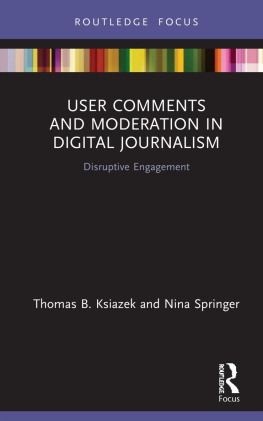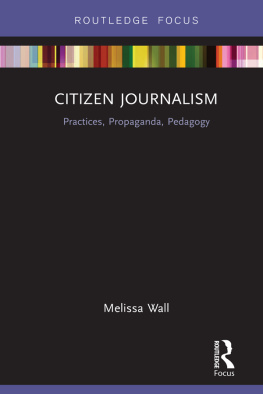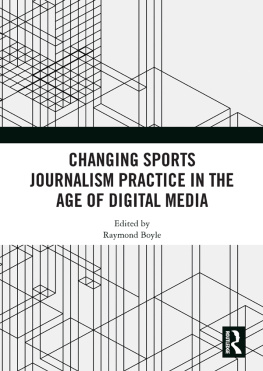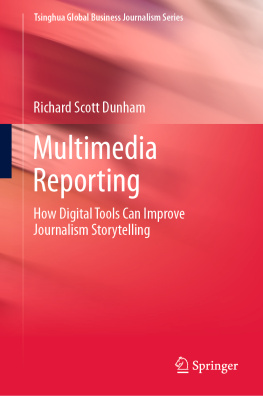
Measurable Journalism
This book explores ways in which the increasingly measurable news audience has had an impact on journalistic practices, in an era when digital platforms provide real-time, individualizable, quantitative data about audience consumption practices.
Considering the combination of digital technology that makes measurable journalism possible, the contributors to this volume examine the work of various actors involved in aspects of measurable journalism both inside and outside the newsroom and confront the normative implications of the data-centric trends of measurable journalism. Including examples from across the globe, the book balances hopes for increased engagement or impact with fears that economic prioritization will hurt journalisms standing in the public sphere.
This book will be of interest to those studying journalistic practices in the modern world, as well as those studying media consumption and emerging digital technologies. This book was originally published as a special issue of Digital Journalism.
Matt Carlson is an Associate Professor in the Hubbard School of Journalism and Mass Communication at the University of Minnesota, Minneapolis, USA. His most recent book is Journalistic Authority: Legitimating News in the Digital Era (2017). He is the author of over 50 journal articles and book chapters.
Measurable Journalism
Digital Platforms, News Metrics and the Quantified Audience
Edited by
Matt Carlson
First published 2020
by Routledge
2 Park Square, Milton Park, Abingdon, Oxon, OX14 4RN
and by Routledge
52 Vanderbilt Avenue, New York, NY 10017
Routledge is an imprint of the Taylor & Francis Group, an informa business
Introduction, Chapters 1, 38 2020 Taylor & Francis
Chapter 2 2018 Raul Ferrer-Conill and Edson C. Tandoc Jr. Originally published as Open Access.
With the exception of Chapter 2, no part of this book may be reprinted or reproduced or utilised in any form or by any electronic, mechanical, or other means, now known or hereafter invented, including photocopying and recording, or in any information storage or retrieval system, without permission in writing from the publishers. For details on the rights for Chapter 2, please see the chapters Open Access footnote.
Trademark notice: Product or corporate names may be trademarks or registered trademarks, and are used only for identification and explanation without intent to infringe.
British Library Cataloguing-in Publication Data
A catalogue record for this book is available from the British Library
ISBN13: 978-0-367-36559-2
Typeset in Myriad Pro
by codeMantra
Publishers Note
The publisher accepts responsibility for any inconsistencies that may have arisen during the conversion of this book from journal articles to book chapters, namely the inclusion of journal terminology.
Disclaimer
Every effort has been made to contact copyright holders for their permission to reprint material in this book. The publishers would be grateful to hear from any copyright holder who is not here acknowledged and will undertake to rectify any errors or omissions in future editions of this book.
Contents
Matt Carlson
Rodrigo Zamith
Raul Ferrer-Conill and Edson C. Tandoc Jr.
Elia Powers
Qun Wang
Valerie Belair-Gagnon and Avery E. Holton
Dumisani Moyo, Admire Mare and Trust Matsilele
Caitlin Petre
Jacob L. Nelson
The chapters in this book were originally published in Digital Journalism. When citing this material, please use the original page numbering for each article, as follows:
Introduction
Confronting Measurable Journalism
Matt Carlson
Digital Journalism, volume 6, issue 4 (May 2018) pp. 406417
Chapter 1
Quantified Audiences in News Production: A synthesis and research agenda
Rodrigo Zamith
Digital Journalism, volume 6, issue 4 (May 2018) pp. 418435
Chapter 2
The Audience-Oriented Editor: Making sense of the audience in the newsroom
Raul Ferrer-Conill and Edson C. Tandoc Jr.
Digital Journalism, volume 6, issue 4 (May 2018) pp. 436453
Chapter 3
Selecting Metrics, Reflecting Norms: How journalists in local newsrooms define, measure, and discuss impact
Elia Powers
Digital Journalism, volume 6, issue 4 (May 2018) pp. 454471
Chapter 4
Dimensional Field Theory: The adoption of audience metrics in the journalistic field and cross-field influences
Qun Wang
Digital Journalism, volume 6, issue 4 (May 2018) pp. 472491
Chapter 5
Boundary Work, Interloper Media, and Analytics in Newsrooms: An analysis of the roles of web analytics companies in news production
Valerie Belair-Gagnon and Avery E. Holton
Digital Journalism, volume 6, issue 4 (May 2018) pp. 492508
Chapter 6
Analytics-Driven Journalism? Editorial Metrics and the Reconfiguration of Online News Production Practices in African Newsrooms
Dumisani Moyo, Admire Mare, and Trust Matsilele
Digital Journalism, volume 7, issue 4 (May 2019) pp. 490506
Chapter 7
Engineering Consent: How the design and marketing of newsroom analytics tools rationalize journalists labor
Caitlin Petre
Digital Journalism, volume 6, issue 4 (May 2018) pp. 509527
Chapter 8
The Elusive Engagement Metric
Jacob L. Nelson
Digital Journalism, volume 6, issue 4 (May 2018) pp. 528544
For any permission-related enquiries please visit:
http://www.tandfonline.com/page/help/permissions
Valerie Belair-Gagnon is an Assistant Professor in the Hubbard School of Journalism and Mass Communication at the University of Minnesota, Minneapolis, USA.
Matt Carlson is an Associate Professor in the Hubbard School of Journalism and Mass Communication at the University of Minnesota, Minneapolis, USA.
Raul Ferrer-Conill is an Assistant Professor in the Department of Geography, Media and Communication at Karlstad University, Sweden.
Avery E. Holton is an Associate Professor and Vice-Presidents Clinical and Translational Scholar in the Department of Communication at the University of Utah, Salt Lake City, USA.
Admire Mare is a Senior Lecturer in the Department of Communication at Namibia University of Science and Technology, Windhoek, Namibia, and a Postdoctoral Researcher in the Department of Communication at the University of Johannesburg, South Africa.
Trust Matsilele is a Lecturer in the Journalism Department at Cape Peninsula University of Technology, South Africa.
Dumisani Moyo is Vice Dean Academic, Faculty of Humanities, and Associate Professor in the School of Communication at the University of Johannesburg, South Africa.
Jacob L. Nelson is an Assistant Professor at the Walter Cronkite School of Journalism and Mass Communication at Arizona State University, Phoenix, USA.








